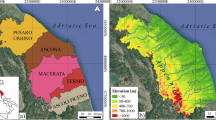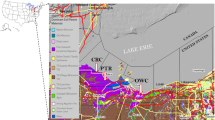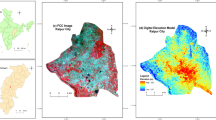Abstract
Detecting near-surface soil freeze-thaw cycles in high-altitude cold regions is important for understanding the Earth’s surface system, but such studies are rare. In this study, we detected the spatial-temporal variations in near-surface soil freeze-thaw cycles in the source region of the Yellow River (SRYR) during the period 2002–2011 based on data from the Advanced Microwave Scanning Radiometer for the Earth Observing System (AMSR-E). Moreover, the trends of onset dates and durations of the soil freeze-thaw cycles under different stages were also analyzed. Results showed that the thresholds of daytime and nighttime brightness temperatures of the freeze-thaw algorithm for the SRYR were 257.59 and 261.28 K, respectively. At the spatial scale, the daily frozen surface (DFS) area and the daily surface freeze-thaw cycle surface (DFTS) area decreased by 0.08% and 0.25%, respectively, and the daily thawed surface (DTS) area increased by 0.36%. At the temporal scale, the dates of the onset of thawing and complete thawing advanced by 3.10 (±1.4) and 2.46 (±1.4) days, respectively; and the dates of the onset of freezing and complete freezing were delayed by 0.9 (±1.4) and 1.6 (±1.1) days, respectively. The duration of thawing increased by 0.72 (±0.21) day/a and the duration of freezing decreased by 0.52 (±0.26) day/a. In conclusion, increases in the annual minimum temperature and winter air temperature are the main factors for the advanced thawing and delayed freezing and for the increase in the duration of thawing and the decrease in the duration of freezing in the SRYR.
Similar content being viewed by others
References
Anandhi A, Perumal S, Gowda P H, et al. 2013. Long-term spatial and temporal trends in frost indices in Kansas, USA. Climatic Change, 120(1–2): 169–181.
Bartsch A, Kidd R A, Wagner W, et al. 2007. Temporal and spatial variability of the beginning and end of daily spring freeze/thaw cycles derived from scatterometer data. Remote Sensing of Environment, 106(3): 360–374.
Brunsell N A, Jones A R, Jackson T L, et al. 2010. Seasonal trends in air temperature and precipitation in IPCC AR4 GCM output for Kansas, USA: evaluation and implications. International Journal of Climatology, 30(8):1178–1193.
Buermann W, Bikash P R, Jung M, et al. 2013. Earlier springs decrease peak summer productivity in North American boreal forests. Environmental Research Letters, 8(2): 024027.
Chai L, Zhang L X, Zhang Y Y, et al. 2014. Comparison of the classification accuracy of three soil freeze–thaw discrimination algorithms in China using SSMI and AMSR-E passive microwave imagery. International Journal of Remote Sensing, 35(22): 7631–7649.
Delbart N, Picard G, Le Toan T, et al. 2008. Spring phenology in boreal Eurasia over a nearly century time scale. Global Change Biology, 14(3): 603–614.
Guo D L, Wang H J. 2014. Simulated change in the near-surface soil freeze/thaw cycle on the Tibetan Plateau from 1981 to 2010. Chinese Science Bulletin, 59(20): 2439–2448.
Han L J, Tsunekawa A, Tsubo M. 2010. Monitoring near-surface soil freeze–thaw cycles in northern China and Mongolia from 1998 to 2007. International Journal of Applied Earth Observation and Geoinformation, 12(5): 375–384.
Henry H A L. 2008. Climate change and soil freezing dynamics: historical trends and projected changes. Climatic Change, 87(3–4): 421–434.
Jin H J, He R X, Cheng G D, et al. 2009. Changes in frozen ground in the source area of the Yellow River on the Qinghai-Tibet Plateau, China, and their eco-environmental impacts. Environmental Research Letters, 4(4): 045206.
Judge J, Galantowicz J F, England A W, et al. 1997. Freeze/thaw classification for prairie soils using SSM/I radiobrightnesses. IEEE Transactions on Geoscience and Remote Sensing, 35(4): 827–832.
Lan Y C, Zhu Y T, Liu G S, et al. 2016. Study of the seasonal characteristics and regional differences of climate change in source regions of the Yellow River. Journal of Glaciology and Geocryology, 38(3): 741–749. (in Chinese)
Li R, Zhao L, Ding Y J, et al. 2012. Temporal and spatial variations of the active layer along the Qinghai-Tibet highway in a permafrost region. Chinese Science Bulletin, 57(35): 4609–4616.
Li X, Jin R, Pan X D, et al. 2012. Changes in the near-surface soil freeze–thaw cycle on the Qinghai-Tibetan Plateau. International Journal of Applied Earth Observation and Geoinformation, 17: 33–42.
Liu X D, Yin Z Y, Shao X M, et al. 2006. Temporal trends and variability of daily maximum and minimum, extreme temperature events, and growing season length over the eastern and central Tibetan Plateau during 1961–2003. Journal of Geophysical Research, 111(D19): D19109.
Luo S, Fang X, Lu S, et al. 2016. Frozen ground temperature trends associated with climate change in the Tibetan Plateau Three River Source Region from 1980 to 2014. Climate Research, 67(3): 241–255.
Matsuoka N, Ikeda A, Sueyoshi T, et al. 2009. Permafrost and hydrology in the source area of the Yellow River. Bulletin of the Geological Survey of Japan, 60(1–2): 39–57.
Matzner E, Borken W. 2008. Do freeze-thaw events enhance C and N losses from soils of different ecosystems? A review. European Journal of Soil Science, 59(2): 274–284.
McDonald K C, Kimball J S, Njoku E, et al. 2004. Variability in springtime thaw in the terrestrial high latitudes: monitoring a major control on the biospheric assimilation of atmospheric CO2 with space borne microwave remote sensing. Earth Interact, 8(20):1–23.
Nan Z T, Li S X, Cheng G D. 2005. Prediction of permafrost distribution on the Qinghai-Tibet Plateau in the next 50 and 100 years. Science in China Series D: Earth Sciences, 48(6), 797–804.
Nicolas D, Ghislain P, Thuy L T, et al. 2008. Spring phenology in boreal Eurasia over a nearly century time scale. Global Change Biology, 14(3): 603–614.
Nishimura T, Kamachi N, Imoto H, et al. 2011. Prefreeze soil moisture and compaction affect water erosion in partially melted andisols. Soil Science Society of America Journal, 75(2): 691–698.
Poutou E, Krinner G, Genthon C, et al. 2004. Role of soil freezing in future boreal climate change. Climate Dynamics, 23(6): 621–639.
Qin D H, Ding Y H, Wang S W, et al. 2002. A study of environment change and its impacts in western China. Earth Science Frontiers, 9(2): 321–328. (in Chinese)
Richardson A D, Keenan T F, Migliavacca M, et al. 2013. Climate change, phenology, and phenological control of vegetation feedbacks to the climate system. Agricultural and Forest Meteorology, 169: 156–173.
Seneviratne S I, Corti T, Davin E L, et al. 2010. Investigating soil moisture–climate interactions in a changing climate: A review. Earth Science Reviews, 2010, 99(3–4): 125–161.
Smith N V, Saatchi S S, Randerson J T. 2004. Trends in high northern latitude soil freeze and thaw cycles from 1988 to 2002. Journal of Geophysical Research: Atmospheres, 109: doi: 10.1029/2003JD004472.
Singh K K, Mishra V D, Sood S, et al. 2013. 3-decadal changes in sea ice melting and freezing pattern in Antarctica using SSM/I data. Journal of the Indian Society of Remote Sensing, 41(4): 947–956.
Sun H, Qin J H, Wu Y. 2008. Freeze–thaw cycles and their impacts on ecological process: a review. Soils, 40(4): 505–509. (in Chinese)
Wang G, Qian J, Cheng G, et al. 2001. Eco-environmental degradation and causal analysis in the source region of the Yellow River. Environmental Geology, 40(7): 884–890.
Wang K, Zhang T, Zhong X. 2015. Changes in the timing and duration of the near-surface soil freeze/thaw status from 1956 to 2006 across China. The Cryosphere, 98(4): 1321–1331.
Wang W B, Shu X, Zhang Q F, et al. 2015. Effects of freeze–thaw cycles on the soil nutrient balances, infiltration, and stability of cyanobacterial soil crusts in northern China. Plant and Soil, 386(1–2): 263–272.
Wang Y B, Wang G X, Cheng Y F, et al. 2006. Response of typical high-cold frozen soil to change of the high-cold ecosystem on Tibetan Plateau. Journal of Glaciology and Geocryology, 28(5): 633–641. (in Chinese)
Wen J, Lan Y C, Su Z B, et al. 2011. Advances in observation and modeling of land surface processes over the source region of the Yellow River. Advances in Earth Science, 26(6): 575–585. (in Chinese).
Xie Y M, Jin R, Yang X G. 2013. Algorithm development of monitoring daily near surface freeze/thaw cycles using AMSR-E brightness temperatures. Remote Sensing Technology and Application, 28(2): 182–191. (in Chinese)
Yang M X, Yao T D, Gou X H, et al. 2007. Diurnal freeze/thaw cycles of the ground surface on the Tibetan Plateau. Chinese Science Bulletin, 52(1): 136–139.
Yi J, Zhao Y, Shao M A, et al. 2014. Soil freezing and thawing processes affected by the different landscapes in the middle reaches of Heihe River Basin, Gansu, China. Journal of Hydrology, 519: 1328–1338.
Yi X S, Yin Y Y, Li G S et al. 2011. Temperature Variation in Recent 50 Years in the Three-River Headwaters Region of Qinghai Province. Acta Geographica Sinica, 66(11): 1451–1465.
Zhang K, Kimball J S, Kim Y, et al. 2011. Changing freeze-thaw seasons in northern high latitudes and associated influences on evapotranspiration. Hydrological Processes, 25(26): 4142–4151.
Zhang L X, Jiang L M, Chai L N, et al. 2011. Research advances in passive microwave remote sensing of freeze-thaw processes over complex landscapes. Advances in Earth Sciences, 26(10): 1023–1029. (in Chinese)
Zhang T, Armstrong R L, Smith J. 2003. Investigation of the near-surface soil freeze-thaw cycle in the contiguous United States: algorithm development and validation. Journal of Geophysical Research, Atmospheres, 108(D22): 1999–2014.
Zhang T, Jin R, Gao F. 2009. Overview of the Satellite Remote Sensing of Frozen Ground: Passive Microwave Sensors. Advances in Earth Science, 24(10): 1073–1083.
Zhang T, Wang K, Zhong X. 2015. Changes in the timing and duration of the near-surface soil freeze/thaw status from 1956 to 2006 across China. Cryosphere Discussions, 8(4): 3785–3809.
Zhang Z Q, Wu Q B. 2012. Predicting Changes of Active Layer Thickness on the Qinghai-Tibet Plateau as Climate Warming. Journal of Glaciology and Geocryology, 34(3): 505–511. (in Chinese)
Zhao L, Ping C L, Yang D Q, et al. 2004. Changes of climate and seasonally frozen ground over the past 30 years in Qinghai–Xizang (Tibetan) Plateau, China. Global and Planetary Change, 43(1–2): 19–31.
Zhao T J, Zhang L X, Jiang L M, et al. 2011. A new soil freeze/thaw discriminant algorithm using AMSR-E passive microwave imagery. Hydrological Processes, 25(11): 1704–1716.
Zheng D, Zhang R Z, Yang Q Y. 1979. On the natural zonation in the Qinghai-Xizang Plateau. Acta Geographica Sinica, 34(1): 1–11. (in Chinese)
Zuerndorfer B, England A W. 1992. Radiobrightness decision criteria for freeze/thaw boundaries. IEEE Transactions on Geoscience and Remote Sensing, 30(1): 89–102.
Acknowledgements
This study was supported by the National Science and Technology Support Plan of China (2015BAD07B02). We sincerely thank the anonymous reviewers and editors for their valuable comments.
Author information
Authors and Affiliations
Corresponding author
Rights and permissions
About this article
Cite this article
Wang, R., Zhu, Q., Ma, H. et al. Spatial-temporal variations in near-surface soil freeze-thaw cycles in the source region of the Yellow River during the period 2002–2011 based on the Advanced Microwave Scanning Radiometer for the Earth Observing System (AMSR-E) data. J. Arid Land 9, 850–864 (2017). https://doi.org/10.1007/s40333-017-0032-4
Received:
Revised:
Accepted:
Published:
Issue Date:
DOI: https://doi.org/10.1007/s40333-017-0032-4




